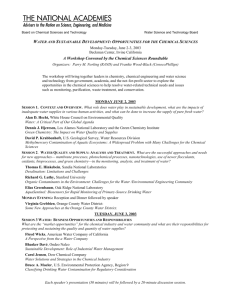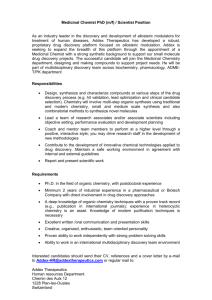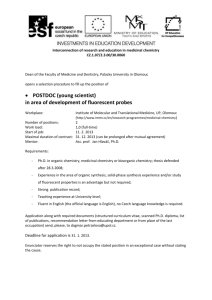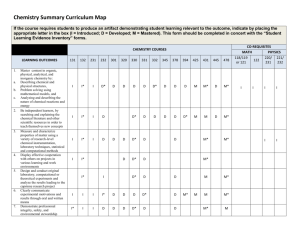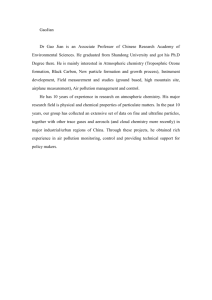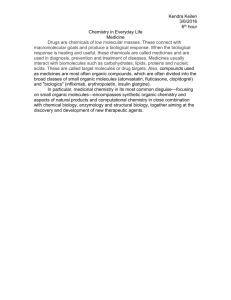Overview
advertisement
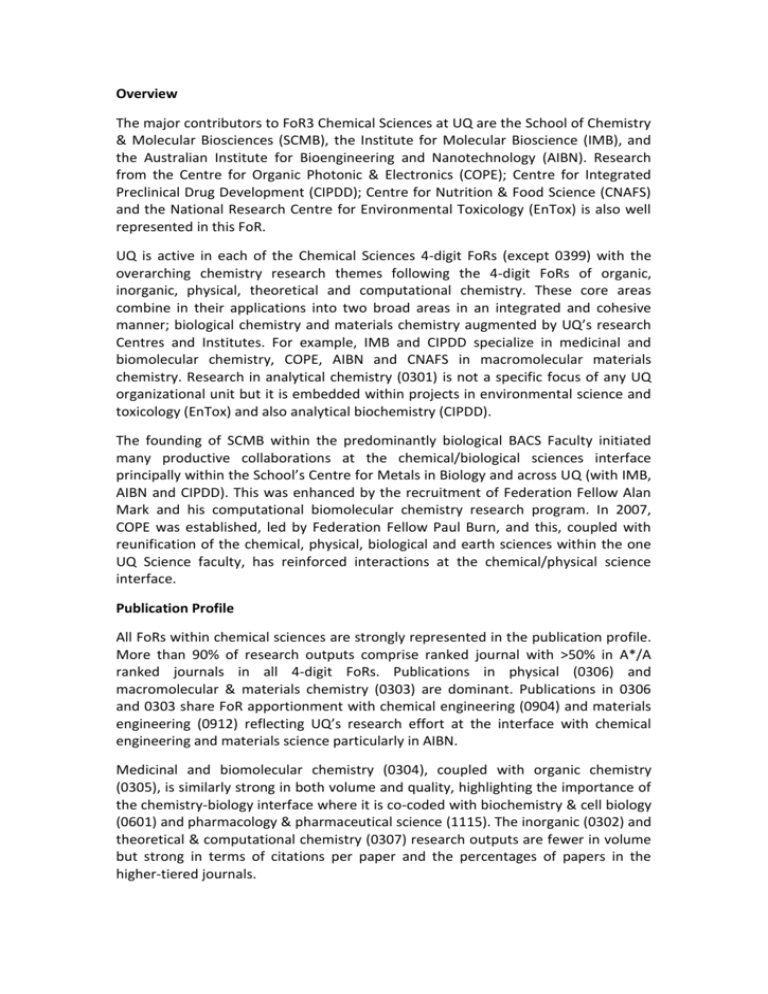
Overview The major contributors to FoR3 Chemical Sciences at UQ are the School of Chemistry & Molecular Biosciences (SCMB), the Institute for Molecular Bioscience (IMB), and the Australian Institute for Bioengineering and Nanotechnology (AIBN). Research from the Centre for Organic Photonic & Electronics (COPE); Centre for Integrated Preclinical Drug Development (CIPDD); Centre for Nutrition & Food Science (CNAFS) and the National Research Centre for Environmental Toxicology (EnTox) is also well represented in this FoR. UQ is active in each of the Chemical Sciences 4-digit FoRs (except 0399) with the overarching chemistry research themes following the 4-digit FoRs of organic, inorganic, physical, theoretical and computational chemistry. These core areas combine in their applications into two broad areas in an integrated and cohesive manner; biological chemistry and materials chemistry augmented by UQ’s research Centres and Institutes. For example, IMB and CIPDD specialize in medicinal and biomolecular chemistry, COPE, AIBN and CNAFS in macromolecular materials chemistry. Research in analytical chemistry (0301) is not a specific focus of any UQ organizational unit but it is embedded within projects in environmental science and toxicology (EnTox) and also analytical biochemistry (CIPDD). The founding of SCMB within the predominantly biological BACS Faculty initiated many productive collaborations at the chemical/biological sciences interface principally within the School’s Centre for Metals in Biology and across UQ (with IMB, AIBN and CIPDD). This was enhanced by the recruitment of Federation Fellow Alan Mark and his computational biomolecular chemistry research program. In 2007, COPE was established, led by Federation Fellow Paul Burn, and this, coupled with reunification of the chemical, physical, biological and earth sciences within the one UQ Science faculty, has reinforced interactions at the chemical/physical science interface. Publication Profile All FoRs within chemical sciences are strongly represented in the publication profile. More than 90% of research outputs comprise ranked journal with >50% in A*/A ranked journals in all 4-digit FoRs. Publications in physical (0306) and macromolecular & materials chemistry (0303) are dominant. Publications in 0306 and 0303 share FoR apportionment with chemical engineering (0904) and materials engineering (0912) reflecting UQ’s research effort at the interface with chemical engineering and materials science particularly in AIBN. Medicinal and biomolecular chemistry (0304), coupled with organic chemistry (0305), is similarly strong in both volume and quality, highlighting the importance of the chemistry-biology interface where it is co-coded with biochemistry & cell biology (0601) and pharmacology & pharmaceutical science (1115). The inorganic (0302) and theoretical & computational chemistry (0307) research outputs are fewer in volume but strong in terms of citations per paper and the percentages of papers in the higher-tiered journals. Capacity and Environment Over the last 7 years, UQ has invested very considerably in infrastructure benefitting research in FoR03. In 2003, the $105M Queensland Bioscience Precinct was completed, housing IMB and constituting a major node of medicinal and biomolecular chemistry research. In 2006, the $76M AIBN was opened with chemical science focus on macromolecular and materials chemistry, and nanotechnology. Concurrently, UQ refurbished and upgraded SCMB Chemistry research facilities to world class, including new research labs that now house COPE. UQ Researchers in FoR03 have been successful in winning ARC LIEF and NCRIS funds for major equipment including a high resolution LC-mass spectrometer (2006 LIEF), a state of the art dual X-ray source single crystal diffractometer (2007 LIEF) and an analytical enantioselective chromatography facility (2008 LIEF). In addition, UQ researchers have access to enabling techniques such as NMR spectroscopy (300, 400, 500, 750 and 900 MHz instruments), an in-house elemental microanalysis facility (in SCMB, one of the few remaining in Australia) and a full-time glassblowing service. Microscopy facilities in the UQ Centre for Microscopy & Microanalysis underpin (nano)materials characterization; high field magnetic resonance equipment for NMR and EPR are provided by the UQ Centre for Advanced Imaging. The recently established Qld node of the NCRIS-funded Australian National Fabrication Facility includes Paul Burn (Deputy Director) and Andrew Whittaker. Environment The staffing demographic of UQ chemical sciences is very balanced with new appointments being made in anticipation of, or coinciding with, retirements of senior academic staff. The FTE staff in the field of Chemistry (mainly in SCMB) has continued to grow over 2003-8. Recruitment and retention of internationally recognized leaders in Chemical Sciences has been facilitated by the ARC Federation Fellowships to Burn (organic optoelectronics), Lu (nanometrials), Mark (computational biomolecular chemistry), Trau (biomaterials and nanotechnology) and Fairlie (medicinal chemistry) and more recently ARC Future Fellowships (Monteiro: polymer chemistry). The 2006 arrival of Bob Gilbert (FAA) from Sydney in the School of Land, Crop & Food Science brought a new focus via a major macromolecular chemistry research program (and a new research Centre, CNAFS). In addition to Fellows of the Australian Academy of Science (Wentrup & Gilbert), there has been a longstanding involvement of FoR03 UQ researchers in its leading learned society, the Royal Australian Chemical Institute (RACI), with past National Presidents (Noller), Branch Presidents (Appleton & Garson, Qld) and Divisional Presidents (Bernhardt, Inorganic Division) playing major roles. Its highest honours (the Leighton Medal and H.G. Smith Medal) have been awarded to UQ staff (Gilbert and Craik) and there are 13 Fellows of RACI at UQ. Senior UQ staff in FoR03 have also served on the Colleges of Experts or panel members for ARC (Lu, Toth) and NHMRC (Fairlie) in addition to the major facility NCRIS (Lu) and LIEF panels (Drennan). Chemical Sciences at UQ has nurtured many ECRs (A and B). On average, 21 ECRs have been employed per year with publications in leading journals and patents. Many of these have taken up subsequent positions at prestigious Institutions around the world including Scripps, Yale, Tokyo, ETH-Zurich, as well as in Australia including UQ, Melbourne, UNSW and Wollongong. More than 120 research higher degrees students were being supervised in FoR3 in 2008 and >75 RHDs were awarded, 2003-8. Funding has been primarily through the APA program, ARC/NHMRC or industry funded PhD stipends in addition to significant numbers of UQ domestic and international scholarships. Collaboration Chemical sciences is an integral part of collaborative research across UQ Schools, Centres and Institutes and externally, addressing major challenges in materials science and biology. Chemical science in IMB is founded on novel drug design and development from organic synthesis to natural products chemistry. Collaborations with pharmacologists and clinicians are a feature. AIBN research tackles human health from the physical chemistry perspective including novel vehicles for drug delivery, improved biomaterials for artificial implants and new diagnostic methods for diseases such as cancer. CNAFS applies polymer chemistry principles to understanding the structure of natural macromolecules such as starch with outcomes in a wide range of areas from nutrition to new starch based materials. COPE is a major collaboration between Chemistry and Physics in the area of organic optoelectronics coupling expertise in synthesis, characterization and theory. Centres and individuals within UQ FoR03 have strong national and international collaborations and internationally: COPE has participated in the DEST-ISL International Consortium on Organic Solar Cells; partnerships in biological and materials chemistry have included the Universities of Sydney, South Pacific, Griffith, Adelaide, and Pennsylvania (USA), ANU, Melbourne Museum, Kurt Gustafason National Cancer Institute (USA), Ning-Hua Tan Kunming Institute of Botany (China), Danish Technical University, Max Planck Institut für Kohlenforschung, (Germany), Harvard Medical School (USA), Santa Caterina Federal University (Brazil), Oxford (UK), St Andrews (UK), and ETH-Zurich, and many others. Finally, it is clear from the level of ARC Linkage Projects funding and direct industrial funding that research in FoR03 has had close collaborations with industry including local biotechnology and drug discovery companies (e.g. Alchemia, Progen, Mediherb, Ecobiotics) as well as internationally-based enterprises. Major Qld government support has been gained for collaborative industry partnerships through the Smart State/NIRAP schemes, with Trau and Whittaker being particularly successful and Smart State Fellowships being awarded to Meredith and Schirra Type Although chemical sciences at UQ is well represented in the fundamental ‘enabling’ research areas of organic, inorganic and physical chemistry, its largest research effort, evident in the ERA income and research output data, is in the applied areas of medicinal & biomolecular chemistry and macromolecular & materials chemistry. This reflects contemporary demand-driven research led by applications related to human health (drug design, drug delivery and novel diagnostic approaches) and sustainability (renewable energy and novel functional materials). Technology transfer is evident by the volume of patents, industry-supported research and spinout companies that have emerged from UQ research in chemical sciences including ElaCor, Nanomics Biosystems, Neurotide etc.

